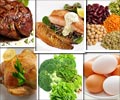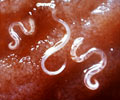Medindia » Multimedia » Slideshows » Foods that Improve Anemia

Anemia is a blood disorder caused by reduced hemoglobin level in the blood. It occurs mainly due to excessive blood loss, reduced production of red blood cell, iron-deficient diet, abnormalities in the upper gastrointestinal tract where most of the dietary iron is absorbed.
To manage anemia, a diet rich in iron is a must. Heme iron that is obtained from animal foods and non-heme iron, obtained from plant foods are the two forms of dietary iron. They are best absorbed when combined with vitamin C.The recommended dietary allowances for iron in adults is 8mg per day for men and 18mg per day for women.Let's take a look at some foods that are rich in iron.
Red meat such as beef and pork, especially their liver, is abundant in iron. For example, 100g (3.5 oz) of beef liver contains 6.1mg of iron but it may not be a top choice for many because of their strong flavor.
A good substitute could be ground beef which contains 3.2mg of iron per serving of 3 oz.People who consume red meat regularly generally do not develop anemia. Red meat contains heme iron, which is better absorbed by the body.
Chicken and turkey help absorb iron in plant-based foods, hence, they are iron enhancers, although they do not contain a great deal of iron.
Three and a half ounce (approx. 100g) of chicken breast provides 2 percent of the daily iron requirement of an adult woman. Iron in chicken thigh is higher at 1.3mg per 100g and provides 10 percent of the daily iron requirement.Iron in chicken is in the form of heme iron and is highly absorbed.
If you want a generous supply of dietary iron from a limited calorie intake then eggs are for you!
One large egg contains about 1mg of iron and the ratio of iron to calories in eggs is 12.5mg per 1000 kcal.Although eggs are considered to be detrimental to bioavailability of dietary iron, the assimilation of iron increases if diets containing eggs are supplemented with ascorbic acid (vitamin C).
Several kinds of shellfish are rich sources of iron. Clams have enough iron in 100g to almost meet the recommended daily intake for women and exceeds that for men.
Oysters, mussels, and shrimp may be included in one's diet as they too contribute significant amounts of iron.Iron concentrations (mg/100g) Clam ____________ 14.0 Oyster ____________ 5.1 Mussel ____________ 4.0 Shrimp ___________ 2.4 Salmon ___________ 0.6
Peanut butter, commonly used as a sandwich spread is a valuable food for anemic people.
It is a good source of iron since only two tablespoons of peanut butter contains 0.6mg of iron.If taken along with a glass of orange juice, the vitamin C in the orange juice will increase the absorption of iron contained in the peanut butter.However, those with peanut allergy have to exercise caution as peanut butter can cause allergic reactions, including anaphylactic shock.
Beans are a great source of iron but they have to be prepared properly as they contain phytic acid which blocks the absorption of iron. The best way to reduce phytic acid content is to soak the beans overnight in warm water before cooking them.
Soybean tops the list as a source of iron. A cup of boiled soybeans contains 8.8mg of iron and meets half the recommended daily requirement of this mineral.But it must be mentioned that soybean is a good iron source only if it is fermented . Hence, soymilk and tofu are not considered iron-rich beans.
Whole grain bread is a good plant- based source of non-heme iron.
The bran of the grain is high in iron content. But just as in beans, whole grains too have iron inhibitors in the form of phytic acid. The best way to reduce phytic acid is to soak or ferment the grains before cooking them. One slice of whole wheat bread contains 0.9mg of iron and meets about 6 percent of the daily value for iron.
Although oats and oatmeal are high in iron (4.7mg per 100g), just like any other grain they too contain phytic acid that inhibit iron absorption.
However,unlike other grains, techniques such as soaking or fermenting are not that effective in case of oats. So, if you are interested in oatmeal as a source of iron, then you'd have to consume fortified oatmeal. Then again, regular oatmeal is generally not fortified with iron but instant oatmeal is.According to the USDA Nutrient Database, a cup of fortified instant oatmeal prepared with water contains 10mg of iron and meets 60 percent of the required daily value for iron.
Grapes are high in iron and contain 0.36mg of iron per 100g.
The amount of iron is same in 1 grape and 1 raisin but because raisins are dried the iron is concentrated. For example, half a cup packed seedless raisins contain 1.5mg of iron that equals 8 percent. However, raisins are loaded with sugar-half a cup of raisins is over 200 calories.Fruits in general do not provide a great deal of iron but researches have shown that prunes and apricots make iron more available because of their high vitamin C content.
Spinach and other green leafy veggies are rich source of iron as well as vitamin C which is necessary for improving iron absorption.
Half a cup of drained boiled spinach contains 3.2mg of iron with 20 percent of daily requirement value. However, spinach and other greens contain high levels of oxalates that not only inhibit absorption of iron but tend to remove iron from the body. But a study published in European Journal of Clinical Nutrition found that 'oxalic acid in fruits and vegetables is of minor relevance in iron nutrition'.
Consume vitamin C because it can help iron absorption in the intestine. Citrus, guava, and tomato are foods that can help the absorption of iron.
Avoid caffeinated drinks such as tea and coffee if you are anemic since they can interfere with iron absorption. Certain medicines too can interfere with iron absorption. MEDINDIA
MEDINDIA




